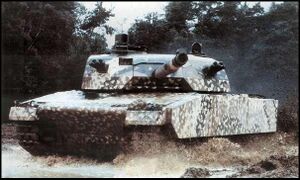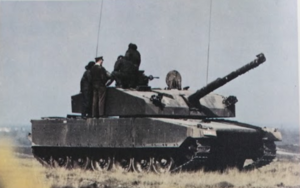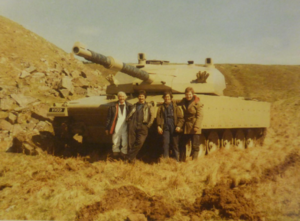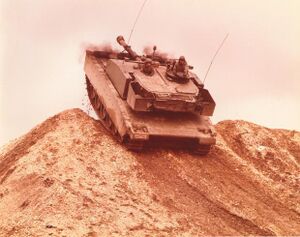Vangsness Vandrer
| Vangsness Vandrer | |
|---|---|
 A Vandrer operating in Førsthavn | |
| Type | Main Battle Tank |
| Place of origin | |
| Production history | |
| Designer | Vangsness Forsvarsfirma |
| Designed | 1977-1981 |
| Manufacturer | Vangsness Forsvarsfirma |
| Produced | 1983-present |
| Specifications | |
| Weight | 43.6 tonnes (48.1 short tons; 42.9 long tons) |
| Length | 10.6 m (34 ft 9 in) gun forward (w/ KjK-55) 7.4 m (24 ft 3 in) hull |
| Width | 3.6 m (11 ft 10 in) w/ side skirts |
| Height | 2.6 m (8 ft 6 in) |
| Crew | 4 (commander, gunner, loader, driver) |
| Armor | Composite |
Main armament | Variable, see Armament |
Secondary armament | 1x coaxial KjMg-73 7.2mm chaingun |
| Engine | 26.1 L ATI CDM12T V12 turbo-diesel 1000 hp @ 2300 rpm |
| Power/weight | 22.9 hp/t |
| Transmission | automatic (6 forward, 2 reverse) |
| Suspension | torsion bar |
| Fuel capacity | 1,100 L (290 US gal) |
Operational range | 470 km (290 mi) |
| Speed | 60 km/h (37 mph) |
The Vangsness Vandrer (also marketed as the Composite Universal Tank) is a privately-developed Trinovantan universal export tank. It was developed alongside the PaVå-33 and took advantage of many of the advancements pioneered by the Militært Kjøretøyteknisk Institutt (henceforth MKI) in developing that vehicle. As per its marketing name, the Vanderer makes notable use of composite armor, specifically the Arendal composite also used by the PaVå-33. Additionally, the vehicle was designed to be highly configurable to easily meet the demands of export customers.
Development
Design work for the replacement of the export-focus Vangsness Voldsom began shortly after its development. The Voldsom was itself a development of the now obsolete PaVå-10, which had been simplified for export as the Vangsness Universal Tank in the 1960s. It was becoming clear that this platform would likely no longer be profitable on the export market. To this end, the proposed future export tank would require an entirely new platform in order to be competitive with other offerings.
From the onset, it was intended that the vehicle would be highly configurable to the needs of foreign buyers. A necessary part of the program was to allow for a large selection of armaments to be used with the vehicle. Though the vehicle went through early tests with a modified Voldsom turret equipped with a 105mm KjK-20 gun, it was always intended for the final vehicle to use what Vangsness described as a “Universal Turret.” This turret would be large and modular, capable of accepting a variety of armament packages.
Using their connections with the MKI, Vangsness got access to early designs for what would become Arendal composite armor. Close cooperation between Vangsness and MKI would continue throughout the tank’s development, with several concepts and components shared between the Vandrer and MKI’s PaVå-33. The ongoing Fifth Ostlander-Trinovantan War also saw shifts in the design priorities of both vehicles, with an increased focus on mobility and fire control systems over preceding design theories.
Due to the war, Vangsness expedited the development of the vehicle, producing a test-ready prototype in June of 1979. The rushed pace of development would continue throughout testing, with the vehicle being declared complete in 1981, in an attempt to draw sales from the Trinovantan Military. However, the tests conducted were not up to the specification of the military and it was determined that it would be harmful to shift factories away from the production of replacement vehicles and parts during wartime conditions. As such, the vehicle received no orders from the Trinovantan Military. Though it had been declared ready for sale, no vehicles would be produced until after the war’s conclusion, and production would be at a relatively low rate for several years as the PaVå-33 was prioritized over the export vehicle to receive new batches of Arendal composite armor.
Design
Armament
A key feature of the Vandrer is what Vangsness calls the “Universal Turret.” This is a large modular turret with configurable armament and ammo stowage. It was developed as a compromise between those who wanted to retain the 105mm gun to make use of existing barrels and ammunition in foreign stocks and those who wanted a more powerful armament to make it more competitive with foreign offerings. With the Universal Turret, both options were available to customers for whichever capability most appealed to them. The armaments could be removed and replaced via removing the mantlet and then dragging the gun forward out of the turret. As such, the armament can be replaced without lifting the turret out of the hull.
The first weapon trialed on the Universal Turret was the KjK-20 105mm L/52 rifled cannon. This older weapon was used on the PaVå-10 and previous Vangsness export tanks. It had large stores of previously manufactured ammunition and parts and continues to receive newly manufactured ammunition to this day. This includes a new tungsten APFSDS round to replace the older APDS ammunition introduced in 1982, shortly before production of the vehicle began. This weapon option was generally aimed at users of older Trinovantan equipment, as the actual cost savings of adopting the 105mm armed vehicle over one of the 120mm options was minimal without having stores of spare parts and ammunition for the gun. With this weapon installed, the turret and hull stowage had enough room for up to 56 rounds of ammunition.
The second weapon option was the 120mm KjK-55 L/55 rifled cannon, as used on the PaVå-22. This gun was significantly more powerful than the KjK-20 and with this gun installed the Vandrer would be a credible threat to almost any foreign tank available at the time. It possessed a similar range of ammunition types, from older APDS and modern APFSDS ammunition to HESH ammunition and even canister and smoke ammunition types. The KjK-55 used two-piece ammunition with separated projectiles and propellants. This allowed for more efficient stowage of ammunition, allowing for 52 rounds of ammunition and their respective propellants to be stowed, but could increase the time it takes to load the gun.
The final option for the Vandrer’s primary armament was the CT-120/86 120mm L/44 smoothbore cannon. Available due to cooperation with the Lumenic Munizioni Reali company later in the Vandrer’s development, this weapon option was made to appeal to export customers in the Omandan region. A modified mount allowed for this weapon to be fitted within the confines of the Universal Turret, which was a relatively easy task as it was smaller overall compared to the KjK-55. This weapon had moderately superior anti-armor performance from its APFSDS ammunition while operating at a much lower pressure than the KjK-55, allowing for a far longer barrel lifespan than the KjK-55 and even the KjK-20. The larger single-piece ammunition reduced the vehicle’s stowage capacity to 44 rounds and the new gun caliber had few options in the way of ammunition when it was offered. Guns and ammunition would also have to be purchased from Luminerra and were subject to any potential restrictions to export from them. Additionally, the weapon was only offered for export after 1986.
The secondary weapon of the Vandrer was the KjMg-73 7.2mm chain gun, which is fitted with 2000 rounds of ammunition ready to fire. This was standard with all primary cannon options of the Vandrer and was chosen for its high reliability, ability to handle large belts of ammunition and the fact that it did not vent gasses into the fighting compartment. It is recommended for the latter reason in particular, as excessive use of the weapon has no chance of compromising the crew when operating under NBC conditions. At the request of customers, different weapons can be fitted to comply with local ammunition standardization, with the mounting able to fit weapons of up to 13mm caliber. An optional pintle mount can be fitted to the commander’s hatch, for machine guns of up to 15mm in caliber.
Protection
The protection and general construction of the Vandrer is very similar to the PaVå-33, largely as a result of both vehicles sharing the use of Arendal composite armor. Arendal is a ceramic composite armor which makes use of multiple layers of ceramic tiles held within a metal matrix. These layers are separated by elastic inserts, and the entire array is backed by a steel backing plate. This kind of armor array is very effective by mass at stopping HEAT warheads while being better than most monolithic armor types at stopping kinetic energy threats. Much like the PaVå-33, the entire frontal arc of the tank from the turret to the lower hull is protected by Arendal armor, with Arendal equipped side-skirts protecting the vehicle from angled shots into its lower hull. The sides of the turret are similarly protected by Arendal for the same reason.
Where the Vandrer differs from the PaVå-33 is that instead of using a hybrid steel and aluminium hull, as the PaVå-33 does, the Vandrer opts instead for a cheaper and less complex to manufacture all aluminium hull. This choice streamlined production significantly, making the vehicle quicker and cheaper to manufacture. Though the aluminium could not support as much armor weight as the hybrid hull of the PaVå-33, the Vandrer was always intended to be within the 40t range at combat weight, which was thought to be within the abilities of an aluminium hull to handle. Unlike the hull, the Universal Turret was constructed out of high hardness steel.
This armor array provided protection against 105mm APDS rounds fired from the KjK-20 across a 50 degree arc from the front of the vehicle. The Arendal composite provided significant protection against ATGMs, being able to defeat the most powerful ATGMs in the Trinovantan arsenal across a 60 degree arc. Against light anti-tank rockets and smaller gun-fired HEAT warheads, the vehicle was protected from both the front and side. The side and rear armor provides protection against 13mm API ammunition and shell fragmentation. This gives it superior frontal protection compared to the PaVå-22 while being over 10 tonnes lighter.
Much like the PaVå-33, the Vandrer is capable of operating in NBC environments. The crew compartment is fully ventilated and the vehicle can be effectively sealed with its overpressure system.
Mobility
The Vandrer makes use of the same ATI CDM12T turbo diesel engine as the PaVå-33, though in this instance the engine is derated to producing 1000 peak horsepower. The reduction in engine power was done primarily to increase the reliability of the drivetrain by reducing input power and the suspension by reducing the speed at which the vehicle could travel. Though the engine had a lower power, the vehicle it was installed in was much lighter than the one it was originally intended for. As such, the loss in mobility from the reduced power was minimal. The Vandrer has a power to weight roughly equivalent to the PaVå-33 and far superior to its predecessors.
The Vandrer lacked the advanced hydrogas suspension of the PaVå-33, instead opting for a simpler torsion bar suspension. This suspension type was generally less expensive and simpler to make parts for, though more difficult to maintain than the hydrogas suspension and contributed negatively to the vehicle’s height. It was also a type of suspension the Vangsness had grown very familiar with, as it equipped their export tanks from the Vangsness Universal Tank onwards. It did have improved characteristics from its predecessors, with up to 365mm of maximum roadwheel travel and each roadwheel being given a shock absorber to reduce jolt from cross country travel.
Sensors and Systems
Improvements to the fire control system were a particular focus in the development of the Vandrer. The vehicle would make extensive use of solid-state computerized systems in its FCS. This included a fairly advanced ballistic computer that incorporated data from several key sensors to produce an accurate firing solution. This fire control system was developed entirely in-house, sharing no components to the PaVå-33’s FCS. It was also intended from the onset to be configurable to each gun option, allowing all three weapons to be used seamlessly without replacing or modifying the FCS or its accompanying sensors.
The gunner’s station has access to a 1x, 5x and 10x optical zoom fixed day/night telescope mounted coaxially with the gun. This telescope is equipped with second generation night vision optics, allowing for use in very low light conditions. There is also a fixed laser rangefinder, which provides highly accurate ranging data both to the gunner and ballistic computer. For target acquisition, the gunner has access to a wide-angle optic mounted on the turret roof.
The commander has access to an independent day/night camera with 1x, 3x, and 10x optical zoom levels. Like the gunner’s optics, this is equipped with second generation night vision systems. When the commander identifies a potential target, he can cue the turret to turn towards the facing of his camera through his command station. The commander’s independent camera can be optionally fitted with a laser rangefinder, which will be connected to the fire control system and will facilitate more rapid engagement of multiple targets. Additionally, the commander has access to a ring of 7 periscopes located around the commander’s hatch. The gunner’s controls are mirrored on the commander’s station, allowing the commander to take over operating the vehicle’s weapons if needed.
The driver has access to three forward facing periscopes, with the central periscope being equipped with day/night optics. Early test variants of the Vandrer used a single wide-angle day/night periscope, but this was found to unacceptably limit peripheral vision and introduced a large visual dead-zone in front of the vehicle due to its low mounting and the shape of the hull.
Options exist to replace either or both of the commander’s and gunner’s optics with thermal imagers, allowing for easier acquisition of targets in both clear and inclement conditions.
Operational History
The Vandrer has seen infrequent use in both Førsthavn and Grønneåser in border clashes and against irregular forces. It has proven itself a relatively tough vehicle for its weight class, especially against lightly armed irregular threats. However, actual combat service has shown several problems that were not found in the vehicle’s much expedited testing. Namely, most testing was done with a lighter turret based on the older Voldsom turret. The Universal Turret, when fully equipped with armor and ammunition, turned out to be heavier than the test turret. As such, when equipped for combat conditions and traveling in high-speed cross-country conditions, excessive stress was put on the aluminium hull causing an increased rate of wear.
The Trinovantan Spesialoppgavegruppe private military company, which operates a company of the Vandrer with the KjK-55, also reported that the firing of the gun could cause the gun cradle to crack or in even more extreme cases caused minor warping of the hull near the front of the turret ring. They also corroborated reports of excessive hull stress from cross country driving.
Variants
- Vandrer ARV - Armored recovery vehicle based on the Vandrer hull.
- Vandrer AEV - Engineering vehicle based on the Vandrer hull, capable of carrying portable bridges or obstacle clearing and anti-mine equipment
- Vandrer SPH - Equipped with a new turret containing a 155mm L/31 howitzer. Not offered for export due to problems in vehicle tests.



